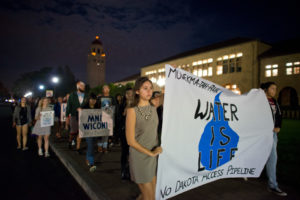Students gathered in White Plaza and marched across campus on Thursday night, calling for an end to the construction of the “Dakota Access” Pipeline (DAPL), which would affect drinking water for more than 18 million people and cut through sacred indigenous sites. The protests were held in solidarity with the ongoing demonstrations in Standing Rock, North Dakota.

DAPL is a 1,100 mile fracked-oil pipeline under construction from the Bakken shale fields in North Dakota to Peoria, Illinois. The pipeline crosses under the Missouri River, the longest river on the continent, and would run through the Great Sioux Reservation laid out by the 1868 Treaty of Fort Laramie.
Student employees at Stanford’s Native American Cultural Center Carson Smith ’19 and Chon Hampson-Medina ’19 began organizing the NoDAPL rally about five weeks ago, finalizing the idea of the rally within the last week.
Smith, who is affiliated with the Choctaw Nation of Oklahoma, explained the significance of DAPL construction for indigenous people.
“[DAPL] calls into question how the government treats sovereign nations like these tribal sovereign nations and not respecting or honoring these agreements,” Smith said.
According to the Standing Rock Tribe’s website, Congress divided the Great Sioux Reservation into six separate reservations in 1889, including the Standing Rock Sioux Reservation. The Standing Rock Sioux Tribe operates under a constitution established by council members in 1959 as a sovereign nation.
DAPL would impact sacred Standing Rock Sioux sites as well as those of other indigenous nations. According to the NoDAPL Solidarity site, the pipelines would renew oil fracking in the Bakken shale region and endanger drinking water for the Standing Rock Sioux and more than 8 million people living downstream. This statistic does not include the 10 million other people who obtain drinking water from the Missouri River’s tributaries.
The company in charge of constructing the pipeline, Energy Transfer Partners, recently released a statement that said they would continue construction despite a joint statement from the Department of Justice, the Department of the Army and the Department of the Interior to stop building in sacred lands. Protectors at Standing Rock are continuing peaceful protest in response.

As an affiliated member of the Winnebago Tribe of Nebraska, Hampson-Medina echoed Smith’s concerns but also raised the problem of drinking water for native and non-native communities alike.
“You literally can’t live without water,” Hampson-Medina said. “This pipeline has the potential to contaminate a body of water that is drinking water for 18 million people, including mostly non-indigenous people.”
The rally featured four student speakers, three of whom were Stanford students.
The first speaker and co-chair for the Stanford American Indian Organization (SAIO), Joseph Manuel ’18, stressed the importance of supporting fellow human beings in times of need.
“My personal dream is that we can stand together and fight for each other’s issues, even though we may differ,” Manuel said.
Manuel said that although the media is covering the protest as an indigenous nation’s issue, the real reason for the protest is water. Students who attended the rally also held signs that stated the protesters’ role as water-protectors.
One event-goer, Cindy Niu ’18, said that she was glad that people saw the bigger picture and how many people understood and reflected.
“Even though we are united under one issue, there are so many different perspectives, and the speakers reflected that,” Niu said.
The other speakers included members of the Indigenous Feminists group and other members of the Native American community.
Following the speakers, participants silently marched to the Oval, giving students time to reflect upon what DAPL meant to them. When asked, Smith said she hoped students understood that the reflection applied to more than just the water-protectors at Standing Rock.
“Families are being affected by this; Stanford students are being affected by this,” Smith said. “It’s not just something that’s going on in another part of the country.”

At the Oval, students stood in solidarity to the reading of a statement from the Standing Rock protest that called for a pledge to “Stand with Standing Rock.”
The rally ended in White Plaza with chanting in honor of the people at Standing Rock, including the phrase “Mni Wiconi,” or “Water is Life.” The event closed with a prayer for the people risking their lives in peaceful protest.
Hampson-Medina added that there will be a national call to action on Nov. 15 for the Standing Rock protests. In the meantime, he encouraged students to take part in spreading awareness.
“This isn’t a fight for indigenous people; this is a fight for all people,” he said. “We must choose the planet over profit. We must choose to Stand with Standing Rock.”
Contact Gillian Brassil at gbrassil ‘at’ stanford.edu.
